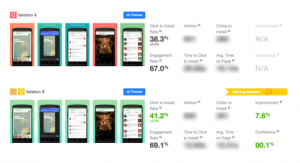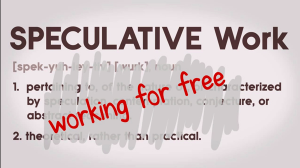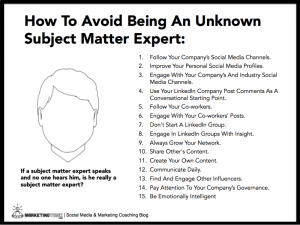So, you’re looking to launch a freelance business as a graphic artist / copywriter / web designer / photographer / motion-graphics artist / SEO expert. My first bit of advice? Narrow down that list. You’re going to be exhausted.
Actually, my first bit of advice would be to think seriously about first spending some time in a job in your chosen creative field — a full-time, W2, in-house job — before striking out on your own as a freelancer. Here’s why.
Based on the zillion articles and blog posts I’m sure you’ve read — not to mention the dozen or so books you’ve skimmed (hey, no judgment) — from experts and coaches, you might have the impression that working as a freelancer from home or from an office you rent means you’ll be living life as a free spirit. You’ll be your own boss, work only when you feel like it, and only on the projects that move you creatively. Plus, if you choose, you’ll be doing a lot of your work on the beach.
But as someone who has run a freelance copywriting business for more than a decade, I have some news for you.
First, the life of a creative freelancer isn’t easier than working for a full-time employer. It’s harder. It might well be more rewarding for you than a job, but it will be more difficult.
And second, other than lifeguards and police officers, the only people who actually spend large amounts of their time working at the beach are those poor souls walking around with metal detectors, hoping to find coins in the sand.
Launching a freelance business is damn hard work, even under the best circumstances. And it’s far more difficult if you don’t have any clients to start with. Or an impressive portfolio of writing samples. Or a strong understanding of the political machinations and pain points at play in your future clients’ companies.
And the fastest way to rack up all of that impressive stuff — the stuff you’ll be able to call your professional expertise — is by first getting a job in your field.
Let me suggest a few reasons that it’s wise to get at least one full-time job under your belt before striking out on your own.
3 Reasons a Full-Time Job in Your Creative Field Can be Invaluable to the Success of Your Freelance Business
Your employer might become one of your first clients
Let’s say you want to launch a freelance business as a graphic designer, and you’ve been working as a full-time designer for a big company for a year or so. You’ve proven yourself a talented, reliable resource to your coworkers there, and you’ve become an expert at delivering what they want from a graphic-design perspective.
And now let’s say you’re ready to strike out on your own. Maybe you’ve saved enough money that you’re comfortable going without a full-time income for a while. Or maybe you’ve lined up another freelance client or two, and you’re confident you’ll be able to land more when you’re no longer in your cubicle all day and can start pitching more aggressively.
Now think of things from your employer’s perspective. You’re about to tell them that you’ve really enjoyed working for them full-time, but you’re launching your own practice now and have to leave. That means they’ll be down one talented, reliable graphic designer who knows their company and has been handling a full-time workload.
Can you think of a better person for your former employer to outsource their ongoing design work to than you?
When you suggest this, they might agree to it immediately. They also might not — particularly if the company has a culture that prefers in-house talent. But even in this case, you can offer to handle their work “just during the transition” while they interview your full-time replacement.
What often happens in that scenario, particularly if you prove equally accessible and reliable as a freelancer, is that even if your former employer plans to replace you eventually, your coworkers find themselves very comfortable just continuing to work with you remotely. They know you, after all, and they like your work.
A word of warning: Approaching your full-time employer with a request to transition to a freelance arrangement does carry some risk. If you’re in a full-time job and considering taking this step, you need to be prepared to lose the security of that job whether or not your company agrees to let you freelance. If they know you are planning to launch your own practice, you could be putting your job at risk.
So I would recommend this maneuver only after you’ve gotten all of the value that you can from your current job and only if you’re truly ready for the job to end.
But when you’re ready to leave your full-time creative position to start a freelance business in that field, you’ll have a far smoother launch for your business when you have a client — a client you already know how to please — from day one.
It will help you quickly build a high-quality portfolio to show prospective clients
One of the best things about starting out in your chosen creative field by working full-time for a company is that you’ll have the full resources of that company helping you quickly build the portfolio of pieces you’ll ultimately be showing off to new clients in your freelance practice.
If you just jump right in to your freelance practice, without any professional experience, what will you have to show your prospects to demonstrate your skill?
Yes, you can mock up your own creative pieces. You can also offer to design a brochure for your cousin’s bakery for free, or take on other small projects for the sake of building a portfolio.
But that won’t necessarily capture your best possible work, or position your freelance business in the way you want prospects to view it.
When you work full-time for a business, you are by definition working for an entity that has enough budget to pay for full-time creative talent. That means they take seriously the image they project and how customers perceive their brand. So if you’re a copywriter working on web pages for that company, you will likely come away from that job with a portfolio of web pages that are designed and coded by professionals — meaning you’ll have a much more sophisticated-looking portfolio.
It doesn’t matter how great a writer you are. If all you have to show prospective clients are Word docs containing drafts of your web copy or ads or white papers, your prospects won’t take you as seriously as they will if they could see your words surrounded by professional design and packaging.
It could generate ongoing leads for your freelance practice, as coworkers from that company move on to new jobs
Another tremendous benefit of working full-time in a company is that you can build relationships with a lot of coworkers there — many of whom will eventually switch jobs, and some, when they need freelance creative talent at those new jobs, will think of you.
This is one of the strongest arguments for devoting your energy in any job not only to delivering great work but also to being easy to work with. People can always find a skilled web designer or photographer or motion-graphics artist — but the ones they truly remember and want to work with again and again are the ones who are positive, professional, reliable, and an all-around joy to work with.
This will be true of every freelance client you take on as well. Any of the contacts you work with at the client’s company might move on to a new job at some point — and when they do, you want to have developed such trust and rapport with them that they think of you immediately when their new company needs the creative services you offer.
But I believe you have even more of an opportunity at a full-time job to develop these relationships with contacts who might hire you wherever they land when they change jobs. That’s because in a full-time position, you’ll be spending a lot more time with these people than you ever will as a remote freelancer. You’ll be working with them every day, and every day you’ll have an opportunity to be easy to work with, or difficult; to meet your deadlines; or miss them; to be a positive member of the team, or a whiner.
Use your full-time job to establish yourself as an irreplaceable creative, and you’ll find your colleagues calling you with freelance work for years to come.
One final suggestion: If you’re a creative freelancer, like an artist or a writer, I would strongly advise you to try to land your first full-time job in a larger company — preferably in an internal creative services department. Here’s why.
When you work on a creative services team — which, in case you’re unfamiliar with the term, is essentially an in-house marketing or ad agency — you’ll have the opportunity to work on lots of different types of projects, often across different brands.
These creative teams are set up as internal service providers to the rest of the company. So a product manager for Brand Family 1 might need a whole set of web pages, while a marketing manager for Brand Family 2 will need a series of ads for a new campaign, and a product marketing manager for Brand Family 3 might want some educational content for the top of the sales funnel — such as white papers, explainer videos or webinars. As a dedicated writer or artist for that team, you might get to work on all of these projects.
This means you’ll quickly get experience working on a range of different types of projects. You’ll quickly build up a diverse portfolio. And you’ll have the chance to work with a lot of different people across the company. (Remember, these might be your future clients if they switch jobs).
It’s also a powerful addition to your bio as a creative freelancer. When you’ve worked for an internal creative team, your clients will know you’re capable of delivering quality work quickly, switching gears and working on a wide range of different types of creative work, and being part of a team. All of that will make you more valuable to all of your future clients.
I hope I’ve convinced you that starting out with a full-time job is the smart way to set yourself up for long-term success as a freelancer. If so, go for it!
Business & Finance Articles on Business 2 Community(79)
Report Post



